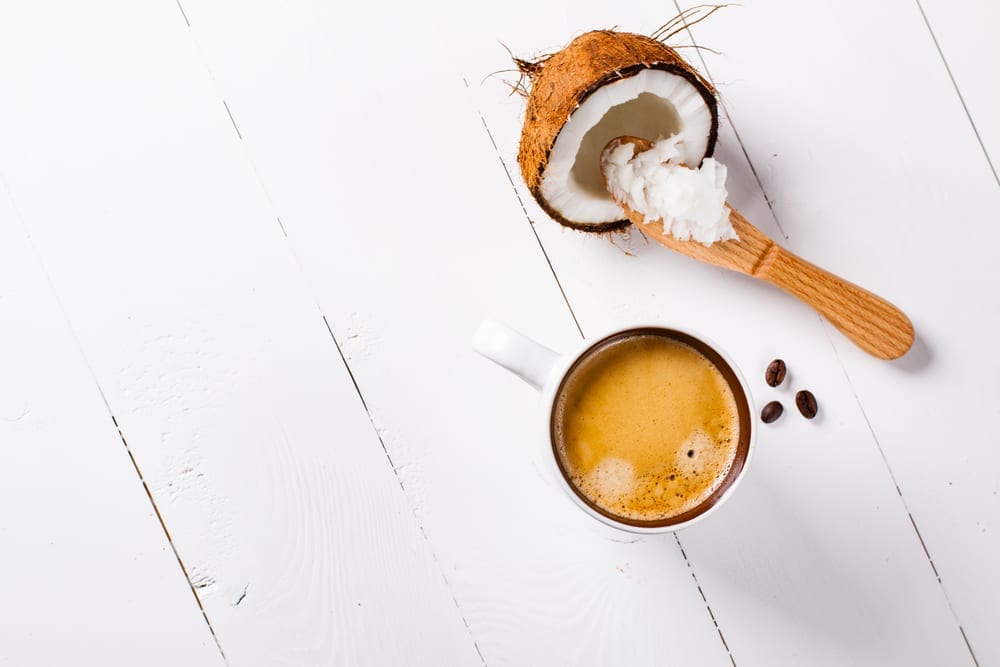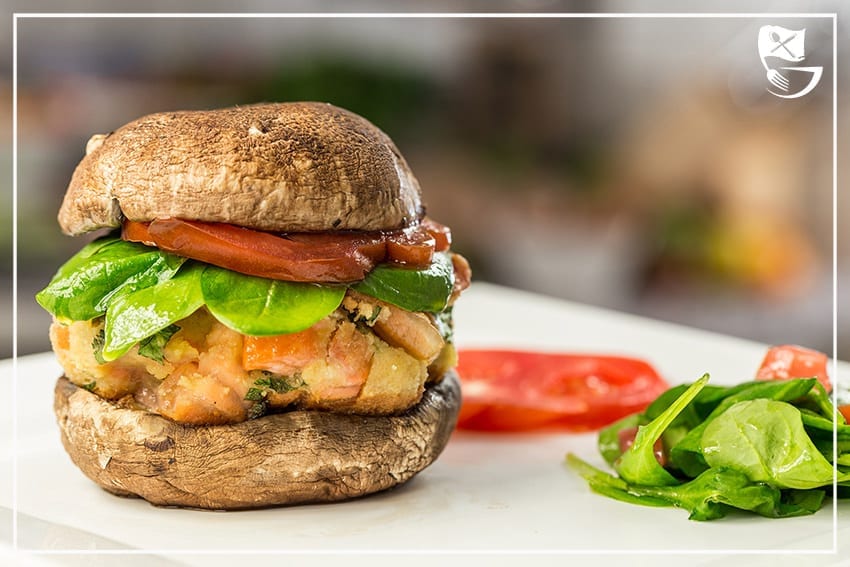Bild: Cegli/shutterstock.com

Bild: Cegli/shutterstock.com
More energy, no performance slump, effortless weight loss – that’s what the Bulletproof diet promises. But what is the truth behind this trend, which is currently spilling over from America to Europe?
Table of contents

The Bulletproof diet is a high-fat diet, based on the Paleo diet. Real food, as unprocessed as possible, is the focus. The Stone Age romantic approach à la “eat only what your ancestor had available in the Stone Age” is spiced up with modern science in the Bulletproof diet. The goal of this diet is to feel as powerful as possible.
Many representatives of the Paleo scene compile an overview that clearly regulates which food is Paleo and which is not. The Bulletproof diet also classifies certain foods as harmful and others as very healthy. But it goes one step further there. Instead of a clear comparison, the inventor of the Bulletproof Diet, Dave Asprey, has created a roadmap. This road map helps you find your way more accurately through the thicket of nutrition. For each food group there is a scale on which foods are classified from “extremely healthy” to “very harmful”. This way, you can decide for yourself at any given time how “awesome” you want to feel, and whether a more negative food is worth just not feeling so “awesome” for once. Awesome means something like “great”, “top”, “outstanding”, “fantastic” or “awesome”. In general, pretty much everything in America is awesome. The sun is awesome, the beach is awesome, “how are you?” – “awesome”… Sometimes you get the feeling that the other person is not really listening to you, no matter what story you tell, the answer is always “Aaawwsome!”. Everyone wants to be awesome, feel awesome, and perform awesome. Dave Asprey hits this nerve exactly with his style. He wants to help people “to kick more ass”, that is, to be insanely successful in everything they do.
Please do not misunderstand. Dave Asprey is an incredibly smart man with an extremely vast wealth of knowledge. At the Bulletproof Conference, despite hundreds of other visitors, he still recognized me by name on the 3rd day. But precisely because he’s so smart, he also knows exactly how to pull the marketing strings to get everyone to jump on it.
There are three aspects that are considered in the Bulletproof diet: The ratio of macronutrients, the type and quality of food, and the timing of meals.
50-70% of calories should be consumed in the form of fat and up to 20% of calories in the form of animal protein. There are plenty of vegetables to go with it, which can add up to 20% of your energy intake (I tried exactly 20%, but barely made it). Finally, there are a few carbohydrates: fruits and starchy vegetables may provide up to 5% of calories.

Here are the perfect diet plans, suitable for the Bulletproof diet.
In addition to macronutrient composition, the Bulletproof Diet looks at the type of food. As with Paleo, there are foods that are absolutely in the red zone of the scale: Soy, gluten-containing grains, sugar, margarine and others. The red area of the scale means: Don’t do that, or you’ll feel pretty miserable! The more of them, the more miserable it gets.
However, even those foods that are generally allowed as part of a Paleo diet are further classified in the Bulletproof diet. Paleo basically means lots of vegetables, good meat and healthy fat. For example, in the Bulletproof diet, pak choy is better than kale. Dave Asprey looks at even the smallest detail of food and judges it based on whether he thinks it is “extremely healthy,” “very healthy,” “healthy,” “not so healthy,” and so on.
Drinks: coffee made from special Bulletproof coffee beans (I mentioned the clever marketing, didn’t I? So no comment here), high quality green tea, diluted coconut milk, water with a little lemon or lime, mineral water from glass bottles.
Vegetables: (organic): Cilantro, Pak Choy (not raw), Brussels Sprouts (not raw), Fennel, Celery, Asparagus, Broccoli (not raw), Cauliflower, Avocado, Cucumber.
Oils and fats: Special Bulletproof brand MCT oil (no comment here either), Bulletproof brand ghee, free-range chicken egg yolks, krill oil (dietary supplement to provide omega-3 fatty acids), bone marrow and fat from pasture-raised cattle, coconut oil, sunflower lecithin (dietary supplement for the brain), avocado oil, chocolate and cocoa butter. Only one step later on the scale comes pasture butter and fish oil (again for omega-3 supplementation).
Nuts and legumes: coconut, olives. One step below on the scale you will find almonds, macadamias, hazelnuts, cashews and pecans. Don’t worry, legumes are listed at the very bottom of the scale under “please don’t”. I must have missed the fact that recently olives are nuts or legumes.
Dairy products: Once again, the special Bulletproof brand ghee, butter from organic pasture milk, colostrum (first milk of the cow, which is said to have immune-boosting properties).
Protein: Bulletproof brand special whey protein (I thought long and hard about whether to write “no comment” again at this point), Bulletproof brand collagen, CollaGelatin of the same brand, pastured beef, pastured lamb, free-range chicken eggs, gelatin from pastured cattle, colostrum.
Starch: sweet potato, yam, carrot, edible pumpkin, butternut squash.
Fruits: blackberries, cranberries (fresh), lemon, lime, avocado, coconut, blueberries.
Spices and flavors: Special private label cocoa powder, special private label vanilla, apple cider vinegar, sea salt, ginger, coriander, parsley, coffee.
Sweeteners: erythritol, xylitol, stevia.
Preparation methods: Raw or uncooked, slightly heated. Quite bad is the microwave, deep frying and frying black.
Of course, you can use other vegetables or protein sources. But those that are entirely on the positive side of the scale are the most effective at achieving weight loss and increasing performance, according to Asprey. It is striking that many of the company’s own products are at the top.
On the one hand, this is absolutely understandable – I would only develop a product that I stand behind 100%, but on the other hand, this list clearly shows the crux of Bulletproof. A lot of valuable and excellently researched info is provided. On the blog, in the podcast, in the book. At the same time, every word is also marketing for the products. As long as they are good products, this is not reprehensible, but natural. But which layman can always judge this correctly?
The third mainstay of the Bulletproof diet is the timing of meals. There are three ways to spread meals throughout the day, depending on your personal goal. In the regular variant, you eat three meals a day. For faster fat loss or better concentration, intermittent fasting is recommended, but only after a period of habituation to the regular Bulletproof diet. In intermittent fasting, breakfast is replaced by coffee with pasture butter and MCT oil.
This sounds strange, but tastes really very good! The coffee must be nicely foamed with a good blender. Then there is no trace of greasy eyes in the coffee, instead a nice frothy coffee that is reminiscent of latte in color. The amount of MCT oil should be slowly increased from 1 tsp to 1 tbsp. Thus, the fact that breakfast does not contain carbohydrates and protein stimulates certain mechanisms in the body that accelerate fat burning and promote cell renewal.
Later, two more meals follow. In both variants, fruits or starchy vegetables should be consumed only in the evening, and coffee only until 2 pm. The third variant is protein fasting. To promote detoxification, it is recommended to consume less than 15 g of protein one day per week, ideally in the form of vegetables. This day is also used as a so-called refeed, where more carbohydrates are eaten. Fruits and starchy vegetables are allowed throughout the day.
The blog bulletproofexec.com and the company Bulletproof were founded by Dave Asprey. He’s an internet nerd from the beginning (he was part of the first company to sell shirts over the internet). Although he was very successful with his tech companies in his younger years, he felt lousy. He was overweight, could not think clearly, and was fatigued. To get his body and brain back on track, he turned to biohacking. From better nutrition to supplements to electrodes on his head, he’s done a lot of testing and has now spent $300,000 to “hack” his body and boost his performance. Along the way, he developed the Bulletproof Diet as the diet that best supported his health and performance. He lost 45 kg and increased his IQ by 20 points, according to his own statement. On his podcast, he regularly talks to brilliant people in the Paleo, biohacking, and health scenes. He’s a tech nerd, biohacking geek, and from my perspective, equally a marketing genius.

Always stay up to date with our Newsletter.
This article was published in the current issue of LCHF (Low Carb – High Fat) magazine. The LCHF diet is similar in many respects to a ketogenic diet and also partly to a Paleo diet. LCHF Magazine is the first German magazine to focus on this low-carbohydrate, high-fat diet. Experts such as doctors and nutritionists regularly write about the health benefits of this low carb diet. In exciting articles, the authors explain in an easy-to-understand way the connections between a LCHF diet and physical and mental health. If you want to learn more about the magazine or subscribe to it, follow this link >> LCHF Germany Magazine.